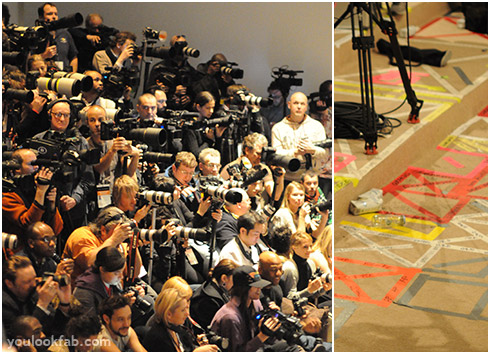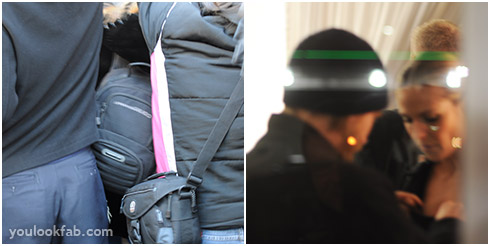This blog post was written by my better half Greg. It’s thanks to his savvy picture taking skills and attention to detail that we could present magnificent photographs of fashion week. Let’s hear all about the photography scene at fashion week.
Understatement: photography at fashion week is a big deal. Wherever you go there are cameras recording every conceivable aspect of the activity. I’ve never seen so many photographers with so much expensive equipment in the same place at once.
As you might expect, the most serious photography happens during the shows themselves. Every venue has a media riser — an area at the end of the runway especially for camera people — that slopes upwards to give the official photographers a clear shot of the models as they near their turn. In the larger venues the media riser real estate is pre-allocated and when the area is clear of people you can see the demarcated spots. Some of the spots seem impossibly small, and some media outlets (like network television channels) have several large spots. If you watch the runway coverage on TV and you see the producer switch between different camera angles, then this channel had multiple spots on the riser.

We didn’t apply for a place on the media riser because we really weren’t there to compete with the professionals for the perfect shot at the end of the runway. We were hoping to capture the feeling of being at the event. My expectations of getting good runway photos was very low to start, but after the first show we realized that with the right position (standing behind the last row of seats was best) and the right exposure settings we could get passable shots. The first show went really well and then the pressure was on to do a repeat performance with the ones that followed. In the end some shows went better than others, but in all cases except one we had some nice representative pictures.
For the camera geeks out there, I used two lenses to get all the runway shots you’ve seen on the blog over the last few days. First, my precious 50mm lens that is extremely fast and therefore works well in low light, and second, a pretty ordinary 70-300mm zoom lens for the shows where I was further away from the runway. I used the aperture priority exposure mode and tried to get the aperture as large as possible to maximize light capture. Exposure compensation of up to negative 3EV was essential because most of the frame is in darkness and the auto setting would therefore tend to over expose the well lit runway model. You can see me getting this right for the Georges Chakra and Irina Shabayeva shows, but over exposing the models a little in the Thuy show (and in this good example from the Carlos Miele show).
I never use flash unless it is absolutely necessary to capture something and the light is too low. I just hate messing with the natural light of the scene.

Outside the shows, but inside the tent, there is a lot of ad hoc photography going on. Anyone wearing anything remotely interesting will be photographed. It looked like some photographers were just taking as many pictures as possible, and I imagine that someone else will sift through these later looking for interesting outfits or celebrities. I enjoyed shooting show attendees the most. There were so many interesting characters, and they were really happy, even flattered, to be photographed.
It gets even more intense when you leave the tents through the main entrance, where a phalanx of photographers is waiting to snap anything on its way in or out. My photo below shows just a fraction of this crowd.

The entrance photographers are hoping to see celebrities, but they won’t see too many big ones. The really big names try to sneak in through one of the many backstage entrances, so at all times of day and night there are paparazzi photographers lying in wait. When we first arrived at Bryant Park I approached a photographer to ask where the press tent was, and he didn’t speak English, much less have an official press pass. Two minutes later we were watching him scramble to shoot the designer of Baby Phat as ten bodyguards tried to sneak her into one of the back entrances.

One thing I learned this past week is that I suck as a paparazzo. On the first day I saw a photographer break into a run after his walkie talkie had squawked something unintelligible. I followed, but was stampeded by the rest of the paparazzi as they too realized that Heidi Klum was out in the open. The photograph on the left below would show Heidi in all her magnificence if there weren’t 10 paparazzi between us.
The following night we were on the street outside an event when Heidi and a friend just breezed past, chatting away, without any handlers at all and no paparazzi in sight. Well, no paparazzi except yours truly. I managed to fumble my camera out of its bag and by the time I was ready to shoot I found myself no more than 5 feet away from her with the glass wall of the building between us.
She looked right at me with an awful look of resignation on her face. I froze like a deer in the headlights, and then put the camera to my eye as much to cover my shameful face as to take a photograph. She turned turned to someone who was pulling her outfit straight. I don’t think I’ve ever felt quite so dirty, but I took the photo.

Photography has always been an occasional hobby for me, something that I loved to do when we traveled. But this fashion week experience took it to a new level. There is something incredibly powerful about capturing a single moment in time. You can go back to that image and pore over it, finding so much interesting detail that you missed when you lived it the first time.
Finally, thank you for all the kind words about the photography in your comments. They were a wonderful boost.









